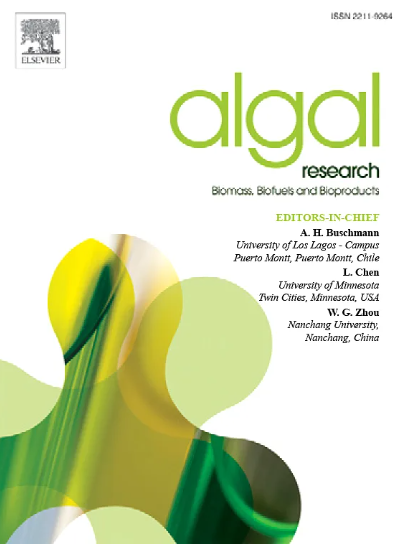光对腹泻贝类毒素产生的矛盾影响——取决于利马原心菌的光合状态和光保护能力
IF 4.5
2区 生物学
Q1 BIOTECHNOLOGY & APPLIED MICROBIOLOGY
Algal Research-Biomass Biofuels and Bioproducts
Pub Date : 2025-06-09
DOI:10.1016/j.algal.2025.104135
引用次数: 0
摘要
腹泻性贝类毒素(DST),包括冈田酸(OA)及其类似物,是蛋白磷酸酶的有效抑制剂,可通过食物链运输,可能导致人类中毒。它们的生物合成在原心藻属和双生藻属是光依赖性的;然而,在我们最近的研究中,它可以被高辐射或紫外线(UV)抑制。方法基于光合状态与DST生产有关的假设,选取2株利马原心菌(SD4,耐光;DS4G4(光敏)在不同光照条件下(12-400 μmol光子m−2 s−1,有/无UV-A)暴露30天。结果高光/UV-A对紫花苜蓿的光合活性(Fv/fm)有抑制作用,随后恢复。值得注意的是,随着第6天光照的增加,DST产量(Rtox)呈指数下降,在菌株DS4G4中更为明显。在光驯化阶段(第6 ~ 18天),Rtox逐渐升高并达到最大值(Rmax),且均随光强呈指数增长。在PAR条件下,两株菌株OA的Rmax的半光饱和强度(Ik)均未超过25 μmol光子m−2 s−1,表明其对DST的要求相对较低。此外,在第6天,弱光和强光下叶绿素a生成速率(RChl a)与Rtox呈不同的相关关系。结论dst的产生与光合状态和菌株特异性光保护能力密切相关。光对DST的抑制是一种不可避免的现象,并进一步探讨了毒素产生与光抑制过程之间的潜在关系。本文章由计算机程序翻译,如有差异,请以英文原文为准。

Contradictive effects of light on diarrhetic shellfish toxin production-depending on photosynthetic status and photoprotection ability of Prorocentrum lima strains
Introduction
Diarrhetic shellfish toxins (DST), including okadaic acid (OA) and its analogues, are potent inhibitors of protein phosphatases and can be transported via food chain, potentially leading to human poisoning. Their biosynthesis in Prorocentrum and Dinophysis genera is light-dependent; however, it can be inhibited by high or ultraviolet radiation (UV) in our recent study.
Methods
Based on the hypothesis that photosynthetic status is relevant to DST production, two Prorocentrum lima strains (SD4, light-tolerant; DS4G4, light-sensitive) were exposed to different light conditions (12–400 μmol photons m−2 s−1, with/without UV-A) for 30 days.
Results
Initially, photosynthetic activity (Fv/fm) was inhibited by high light/UV-A, then recovered. Notably, the DST production rate (Rtox) decreased exponentially with increasing light on day 6, more significantly in strain DS4G4. During photoacclimation (day 6 – day 18), Rtox increased and attained a maximum (Rmax), which in all cases was exponentially increased with light intensity. Under PAR conditions, the half-light saturation intensity (Ik) for Rmax of OA did not surpass 25 μmol photons m−2 s−1 in both strains, highlighting the relatively low light requirements for DST production. Additionally, on day 6, chlorophyll a production rate (RChl a) demonstrated different correlations with Rtox under low and high light.
Conclusion
DST production is tightly associated with photosynthetic status and strain-specific photoprotection ability. The inhibition of DST by light is an inevitable phenomenon, and the underlying relationship between toxin production and photoinhibition process was further explored and discussed.
求助全文
通过发布文献求助,成功后即可免费获取论文全文。
去求助
来源期刊

Algal Research-Biomass Biofuels and Bioproducts
BIOTECHNOLOGY & APPLIED MICROBIOLOGY-
CiteScore
9.40
自引率
7.80%
发文量
332
期刊介绍:
Algal Research is an international phycology journal covering all areas of emerging technologies in algae biology, biomass production, cultivation, harvesting, extraction, bioproducts, biorefinery, engineering, and econometrics. Algae is defined to include cyanobacteria, microalgae, and protists and symbionts of interest in biotechnology. The journal publishes original research and reviews for the following scope: algal biology, including but not exclusive to: phylogeny, biodiversity, molecular traits, metabolic regulation, and genetic engineering, algal cultivation, e.g. phototrophic systems, heterotrophic systems, and mixotrophic systems, algal harvesting and extraction systems, biotechnology to convert algal biomass and components into biofuels and bioproducts, e.g., nutraceuticals, pharmaceuticals, animal feed, plastics, etc. algal products and their economic assessment
 求助内容:
求助内容: 应助结果提醒方式:
应助结果提醒方式:


